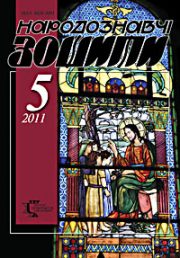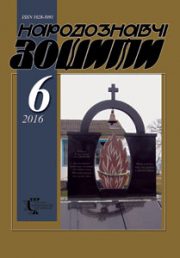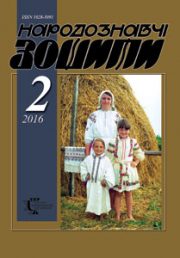The Ethnology Notebooks. 2020. # 6 (156), 1273—1286
УДК 679.85: 745(477.44)”19/20″
DOI https://doi.org/10.15407/nz2020.06.1273
Anna TROTSENKO
- ORCID ID: http://orcid.org/0000-0002-1240-0752
- Postgraduate student,
- Kyiv National University of Culture and Arts,
- 36, E. Konovaltsya Str., 01133, Kyiv,Ukraine,
- e-mail: Ann_Alyoshkina@ukr.net
ARTISTIC STONE CUTTING IN THE BUKATYNKA VILLAGE, VINNITSIA REGION, UKRAINE (XX—XXI CENTURY)
The relevance of the topic depends on the need to survey remote unknown stone communities in order to obtain a broad picture of artistic stone cutting in Ukraine. Artistic heritage of Bukatynka, the stone cutting village in Mohyliv-Podilskyi district in Vinnytsia region, was insufficiently studied by scientists.
For this study, we analyzed the data collected from several research trips to Bukatynka in order to explore stone objects. We performed additional data collection by recording interviews with a few local people, who could give us valid ethnographic information. The third source of information was the local archive data. The aim of the article is to provide comprehensive coverage of Bukatyn stone cutting art phenomenon in XX—XXI centuries based on newly collected material. The object of the research is the works of local stone craftsmen, the subject is the art features and specifics of crafting ornamented stone objects in this region of Ukraine.
The examination of the village cemetery allowed to discover various types of ritual objects: monuments of the noble, «oak-type» tombstones, obelisks, simple modernized tombstones, works of professional sculptures. The article contains an art description of different memorial objects, including their difference and distinctive properties, influenced by various cultural developments. Evolutionary changes in tombstone shapes are presented in chronological order, the study covers more than a century of stone crafts. The architectural structure and surface decoration of the stone art is duly highlighted. The «oak-type» monuments are analyzed in detail; they show different variations of form and decorative solutions, as well as a long tradition of installation in Mohyliv-Podilskyi district, Vinnytsia region.
Archive data help to study history and the reasons of rapid development of the local stone cutting industry. Interviews with informants (local villagers) allow to cover the environment and working conditions of the craftsmen. The methods of the study are: historiographic approach, art history analysis and interview method.
The novelty of the study is represented by the lists of Bukatynka stone craftsmen published the first time. Also many unknown art objects of ХХ—ХХІ centuries are brought to light and now available for scientific research. These objects will fill the blanks in the history of Ukrainian memorial stone culture.
Keywords: Bukatynka, artistic stone processing, stonecraft, stone cutting, tombstones, stone crosses.
REFERENCES
- Jabіonowskyi, A. (Ed.). (1894). Zrodіa dziejowe. Polska XVI wieku pod wzgldem geograficzno-statystycznym, Ziemie ruskie. Ukraina (Kijуw — Bracіaw) (Vol. XX1). Warszawa [in Polish].
- Setsynskyj, Ye. (1901). Parishes and Churches of the Podolian Eparchy. In: Proceedings of the Podolian Eparchial Historical and Statistical Committee (Issue IX). Kamenets-Podolskyj: S. Kyrzhatskyi Publishing House [in Russian].
- Sherotskyj, K. (1908). Tombstones in Ukraine. In: Mykhaylo Hrushevskyi, compiler, Proceedings of the Shevchenko Scienific Society (Vol. 82, bk. 2, pp. 10—29). Lviv: SSS Publishers [in Ukrainian].
- Scherbakivskyj, D.М. (1926). The Ukrainian Art (Vol. 2): Bukovyna and Halychyna Wooden Churches, Tombstones and Roadside Crosses, Figures, and Chapels. Kyiv: Ukranian Public Publishing Fund [in Ukrainian].
- Aleksandrovich, G.S. (1916). Stonecutter-handicraftsmen and Artisans of the Podillia Governorate (Pp. 1—36). Kyiv Stefan Kulzhenko Lithography [in Russian].
- Chahovets, T. (1994). From the observations of the Folk Stoneculling Craft in the Late XIXth to Early XXth Century. In Roman Kyrchiv, Oleh Kupchynskyi, eds. in chief, Proceedings of the Shevchenko Scienific Society. Papers of Ethnography and Folklore Studies Section (Vol. CCXXX, pp. 200—211). Lviv [in Ukrainian].
- Artiukh, L.F., Balushok, V.H., & Boltarovych, Z.Ye. (1994). Podillia: A Historical and Ethnographic Study. Kyiv: Dolia [in Ukrainian].
- Mozdyr, M.I. (1996). The Ukrainian Folk Memorial Sculpture: A Monograph. Kyiv: Naukova dumka [in Ukrainian].
- Mozdyr, M.I. (2009). The Ukrainian Folk Memorial Plastic Art: A Monograph. Lviv: NAS of Ukraine, Institute of Ethnology [in Ukrainian].
- Alioshkin, O. (2002). Solidified Drops of Millennia, or the Oaklet-Opening Holiday. In: Rostyslav Zabashta, scientific editor, Genealogy: Scientific Notes for the Cultural History, 1—2 (18—19), 138—141 [in Ukrainian].
- Khomyak L. (2002). Memorial Carving of Narayiv Stonecutters. In: Rostyslav Zabashta, scientific editor, Genealogy: Scientific Notes for the Cultural History, 1—2 (18—19), 142—151 [in Ukrainian].
- Khomyak, L.V. (2002). Memorial Carving of Stonecutting Craft Centres in Halychyna in the Late XIXth through XXth Century. Ph.D. in Art Criticism thesis. Specialty: 17.00.06. Ivano-Frankivsk [in Ukrainian].
- Malyna, V. (2002). Decorating Stone Crosses. In: Rostyslav Zabashta, scientific editor, Genealogy: Scientific Notes for the Cultural History, 1—2 (18—19), 95—107 [in Ukrainian].
- Malyna, V.V. (2009). Stone crosses in Ukraine. XVIIIth to XXth Centuries: Ontology. Typology. Symbolics. Function. Mykolayiv: Art Goods Artil [in Ukrainian].
- Kosakivsky, V.A. (Ed.). (2009). Busha: nature, archeology, history, ethnography and folklore of the villages of Bushan village council. Vinnytsia: Vinnytsia newspaper [in Ukrainian].
- Ivanchyshen, V.R. (2017). Stonecutting of Eastern Podillia in the Late XIXth to Early XXIth Centuries: Common and Sacral Dimensions. Kyiv: Naukova dumka [in Ukrainian].
- Trotsenko, A. (2019). Artistic peculiarities of the stone tomb crosses of the Bukatynka village, Vinnytsia region in the Late XIXth to Early XXIth Centuries. Art Studies: Theater. Music. Cinema. Architecture. Fine and decorative arts, 3/4 (67/68), 64—76 [in Ukrainian].
- CDIAK of Ukraine. F. 258. Оp. 1. Sp. 158.
- Ivanchyshen, V. (2014). Centers of stonecutting of Eastern Podillia in the Late XIXth to Early XXIth Century (on the example of the village of Busha, Yampil district, Vinnytsia region). Ethnic history of the peoples of Europe (Issue 44, pp. 65—69) [in Ukrainian].
- DAViO. F. R-2700. Op. 3. Sp. 61. Information from regional organizations about the work of the cooperative industry and the communal bank (Arc. 12). (List of industrial collectives of the system of industrial cooperation, which is in charge of reorganization for the decision of the CPC USRR…) (state for 1933) [in Russian].
- DAViO. F. R-2355. Op. 1. Sp. 40. Case №. 1 with reports on the census of industrial enterprises in the region for 1940. January 1, 1940 — October 17, 1940 (Arc. 61). (List of large-scale industrial enterprises for 1940) [in Russian].






